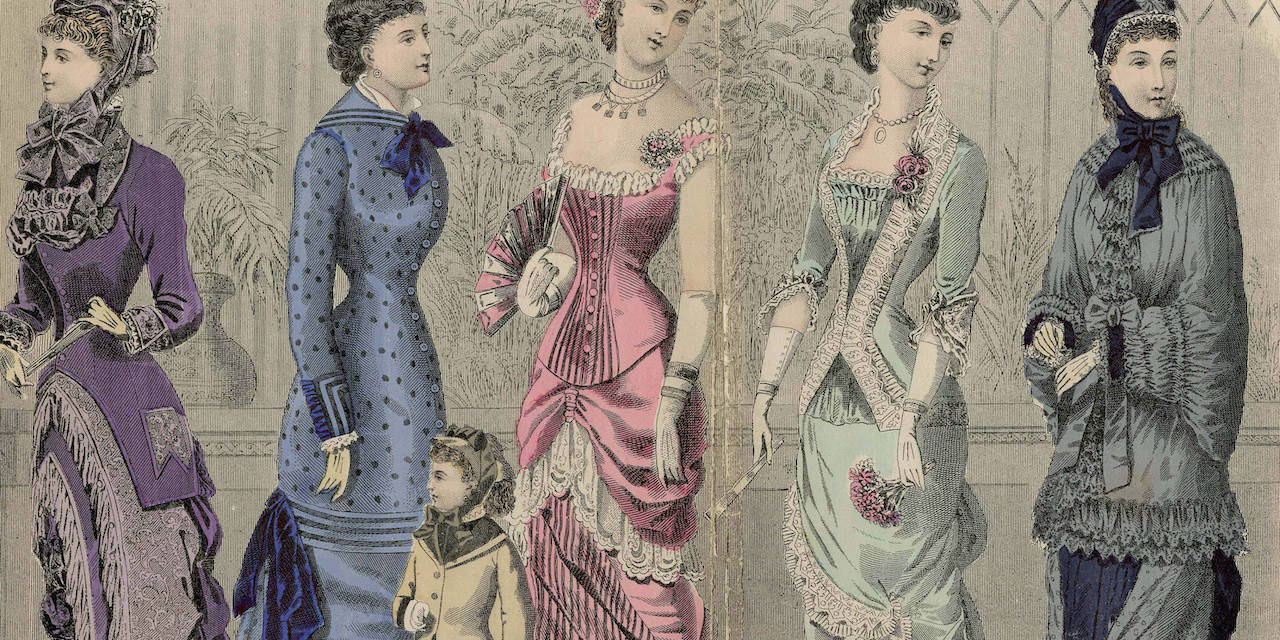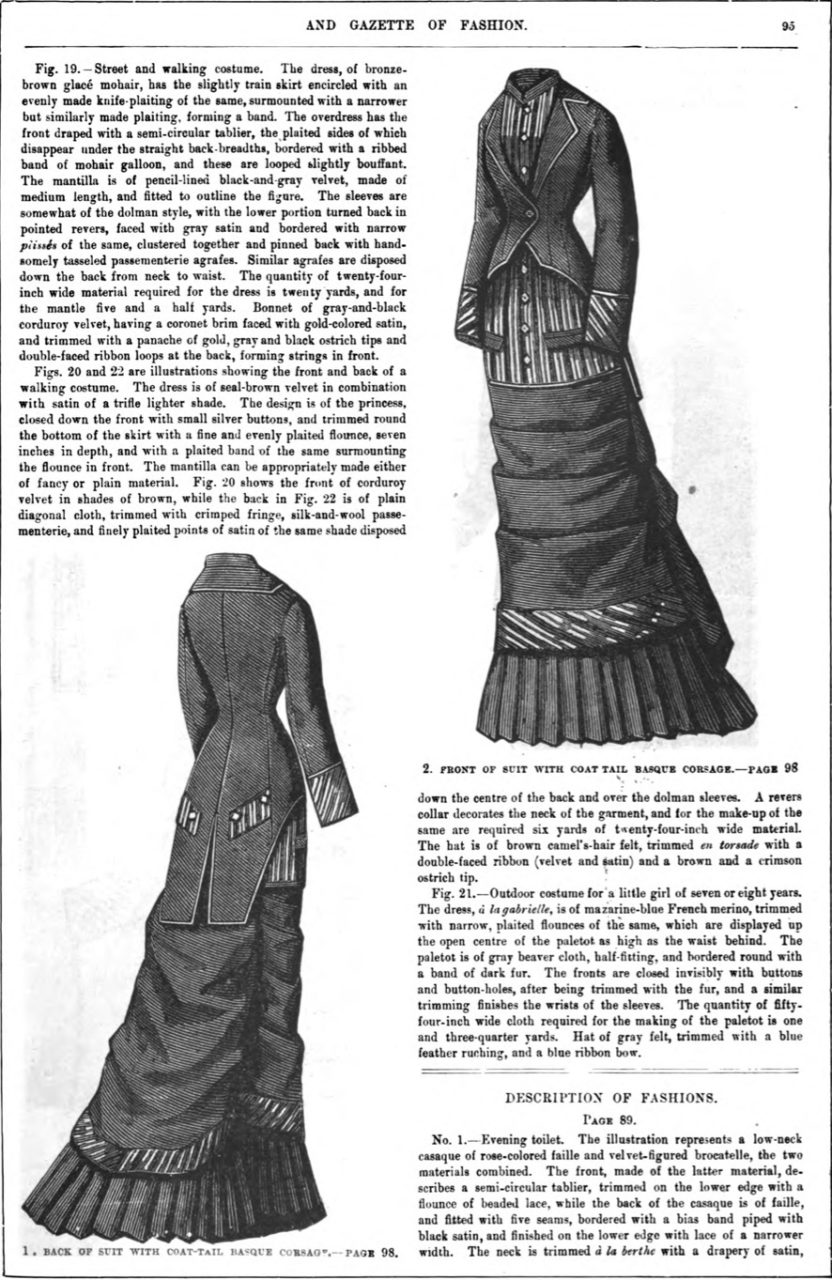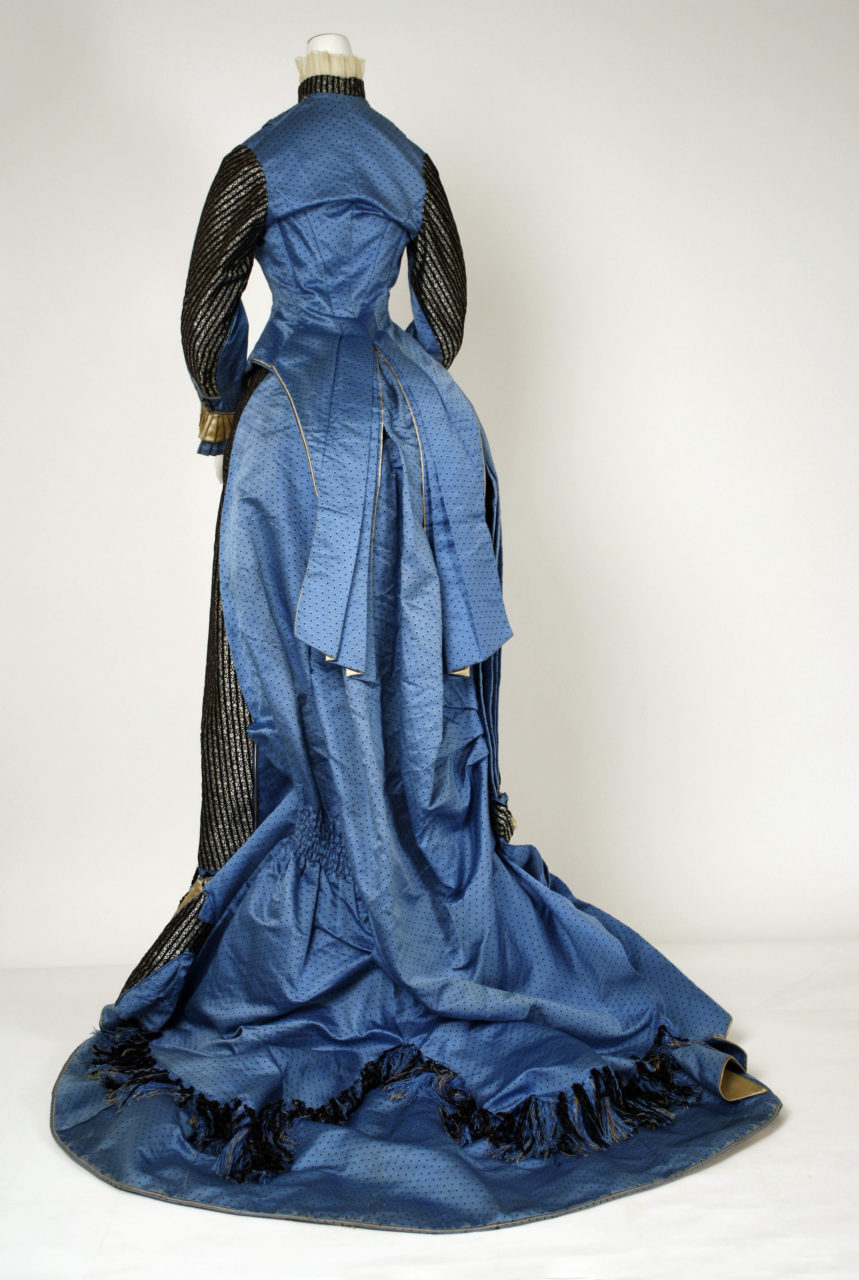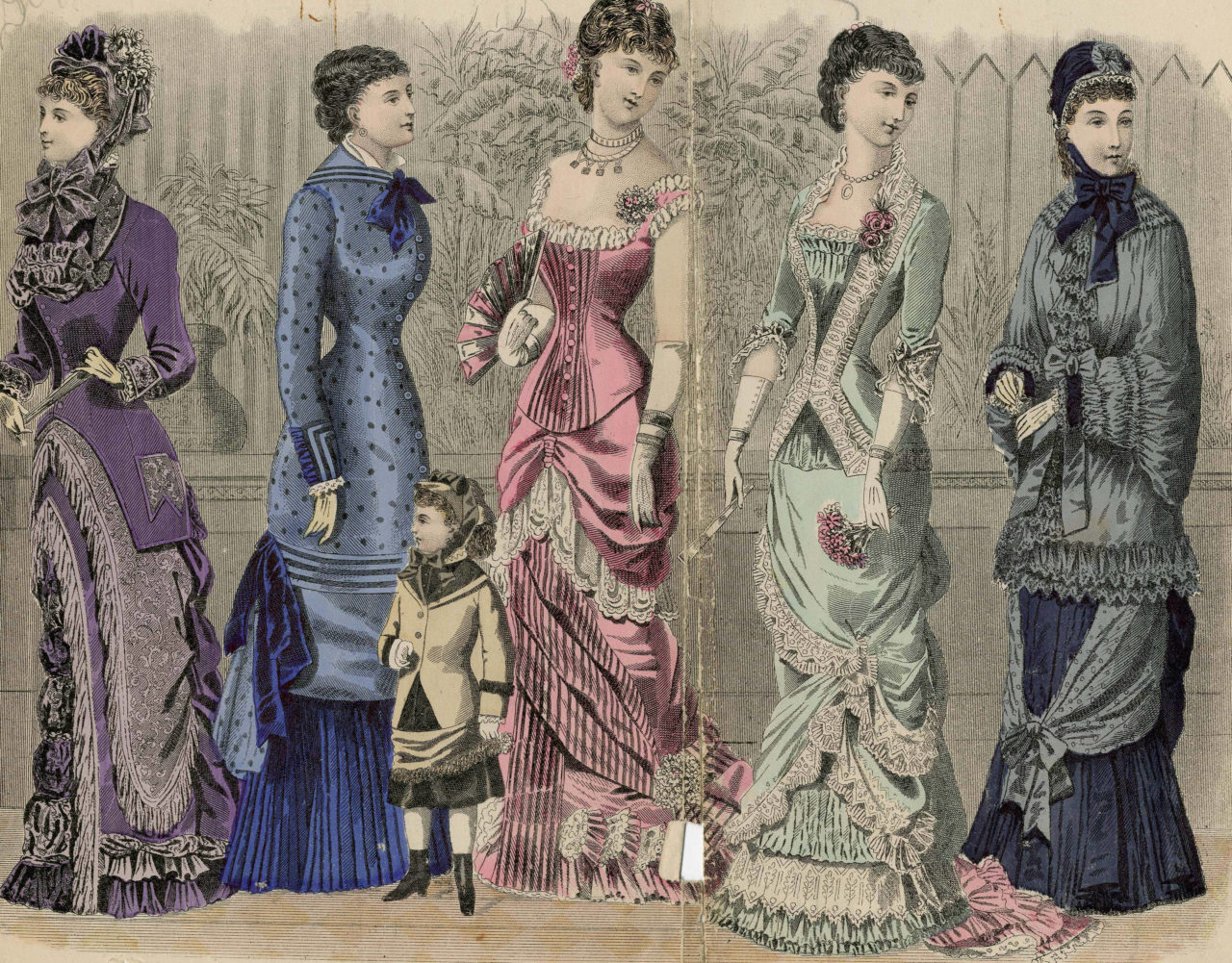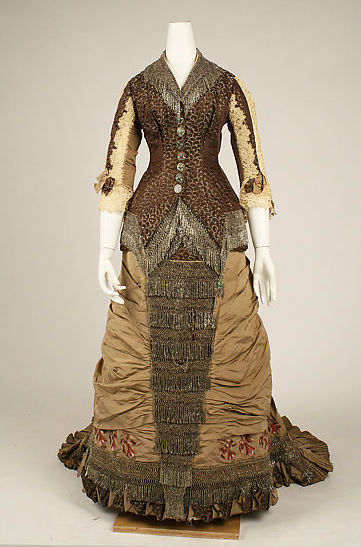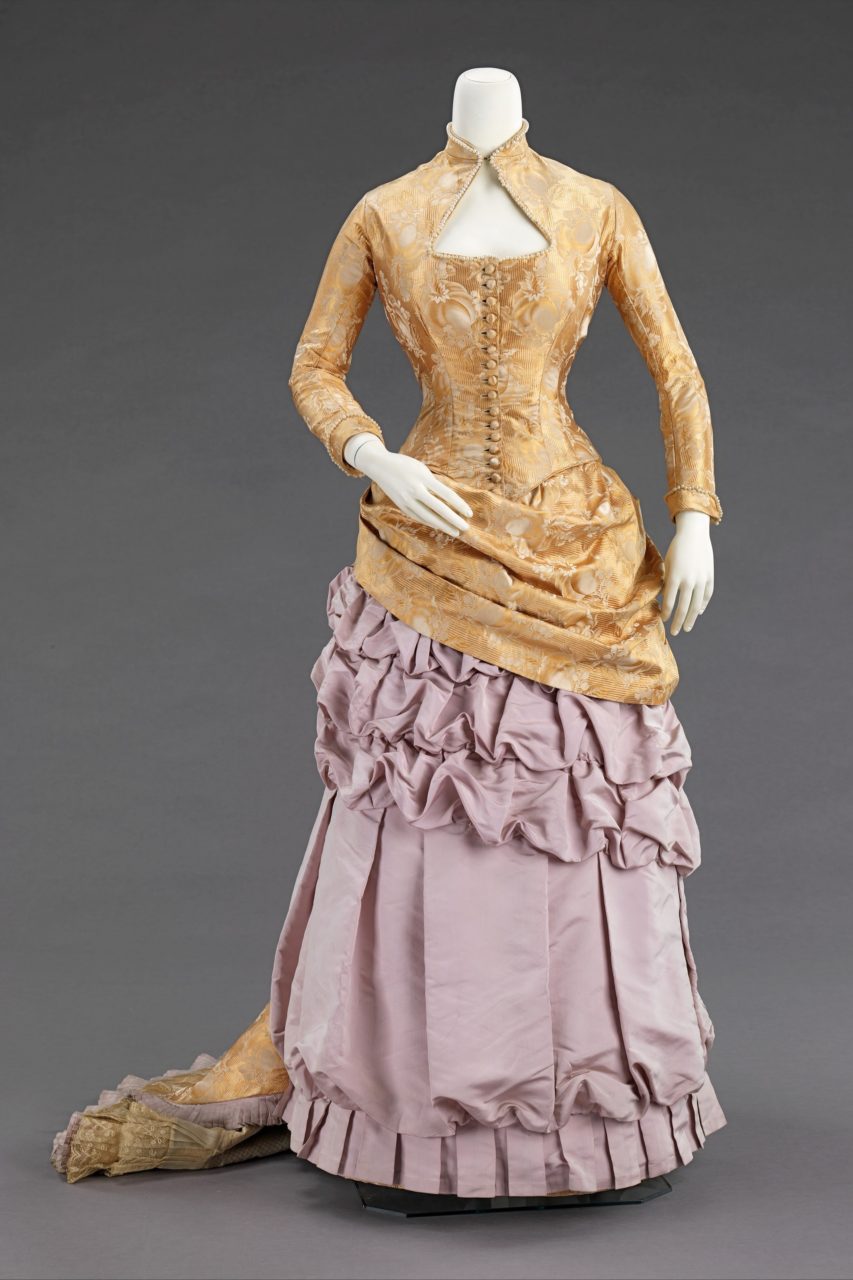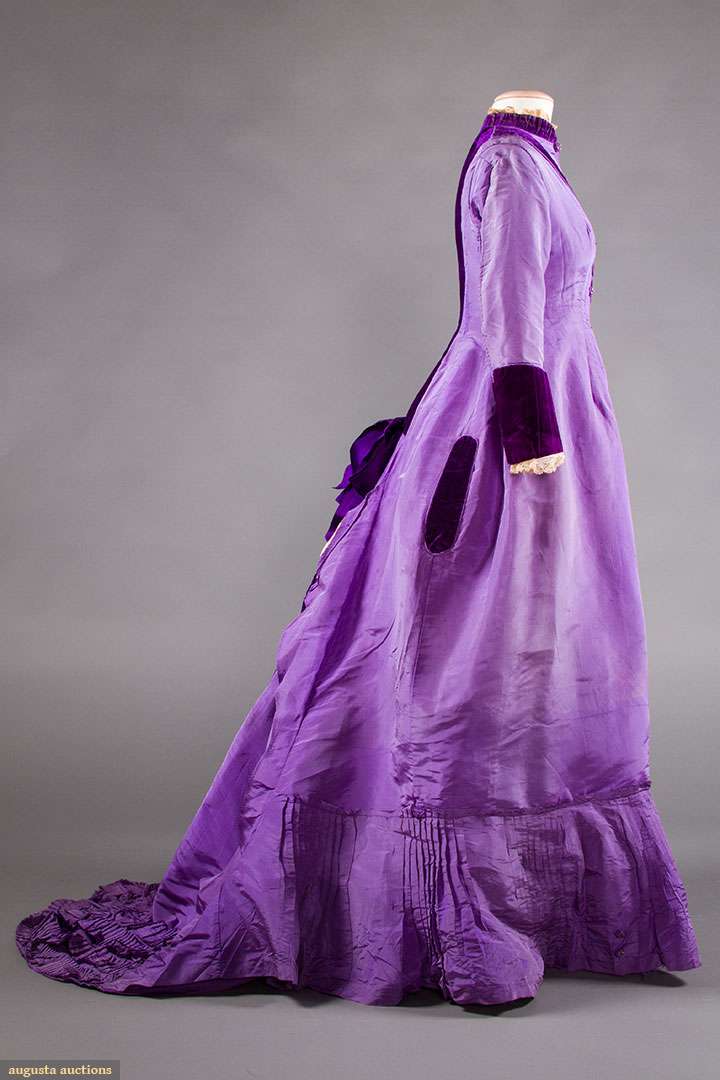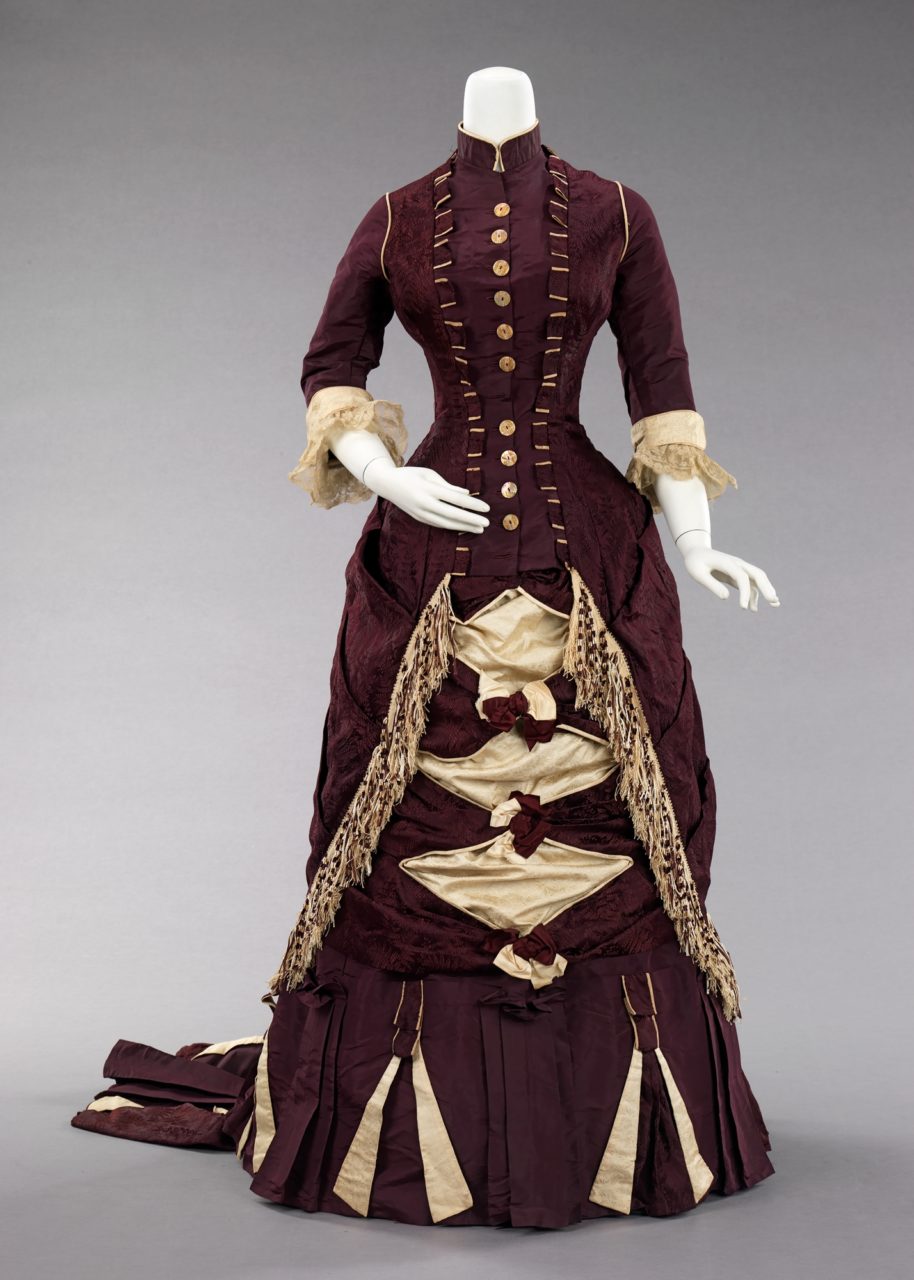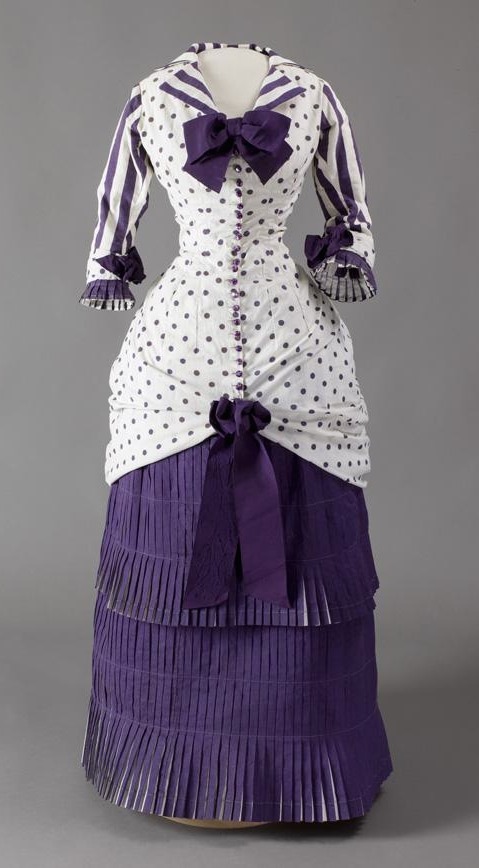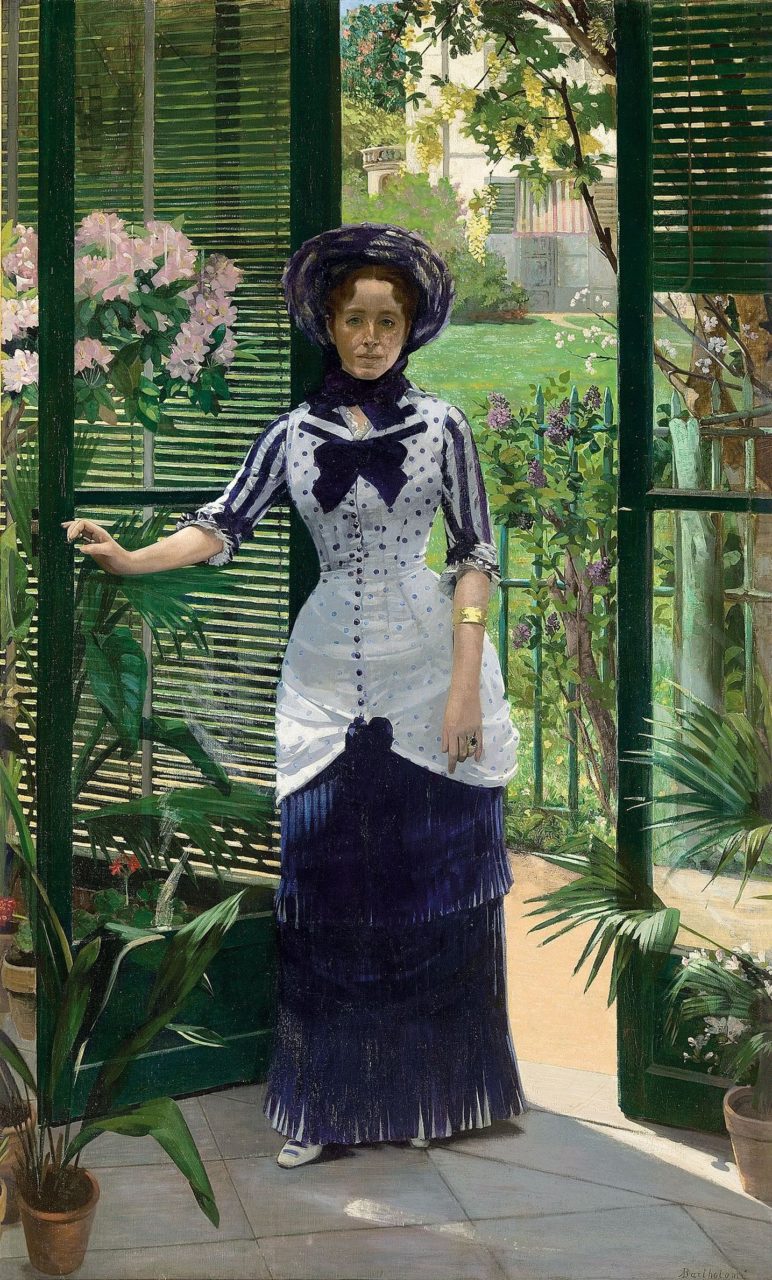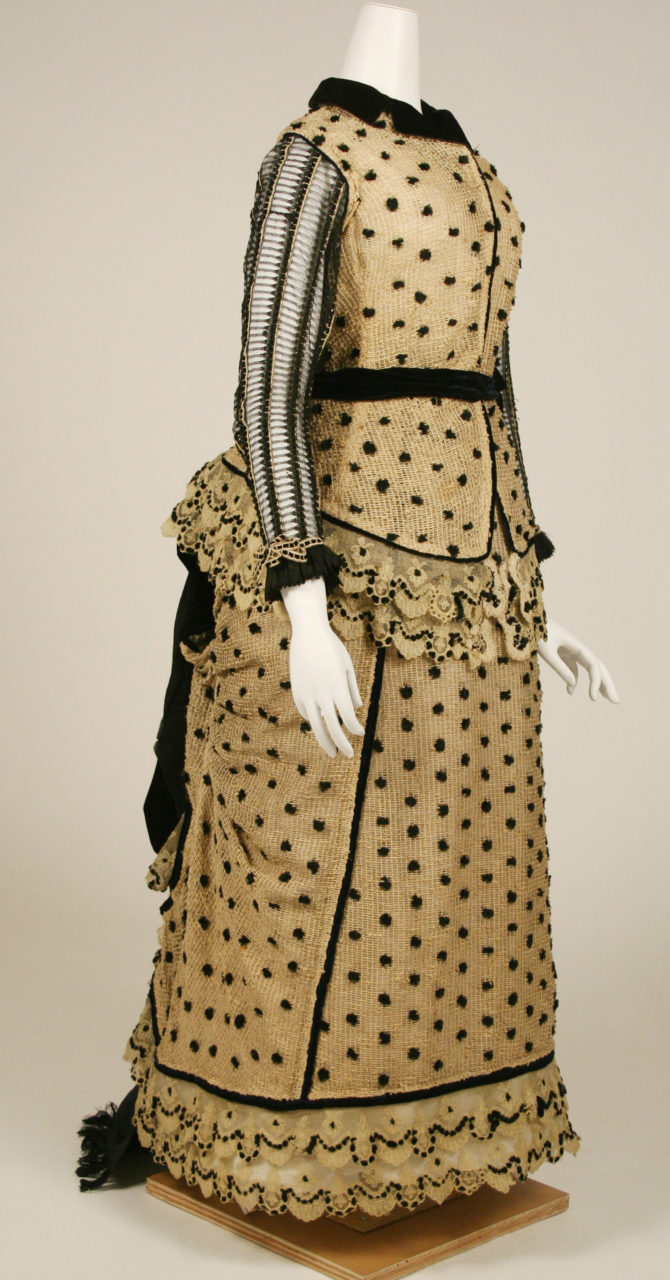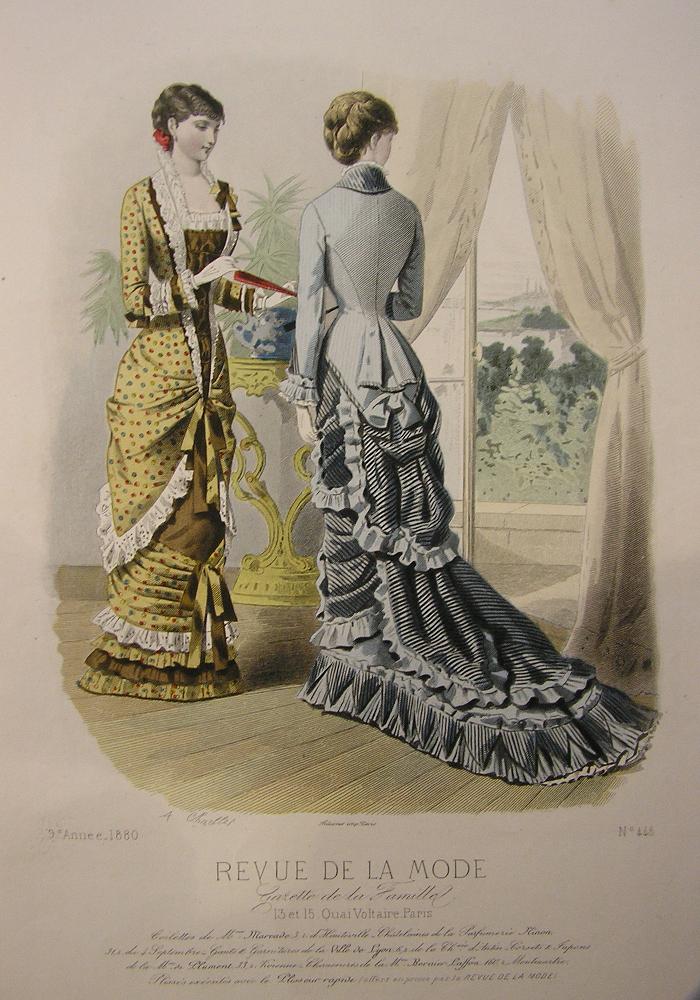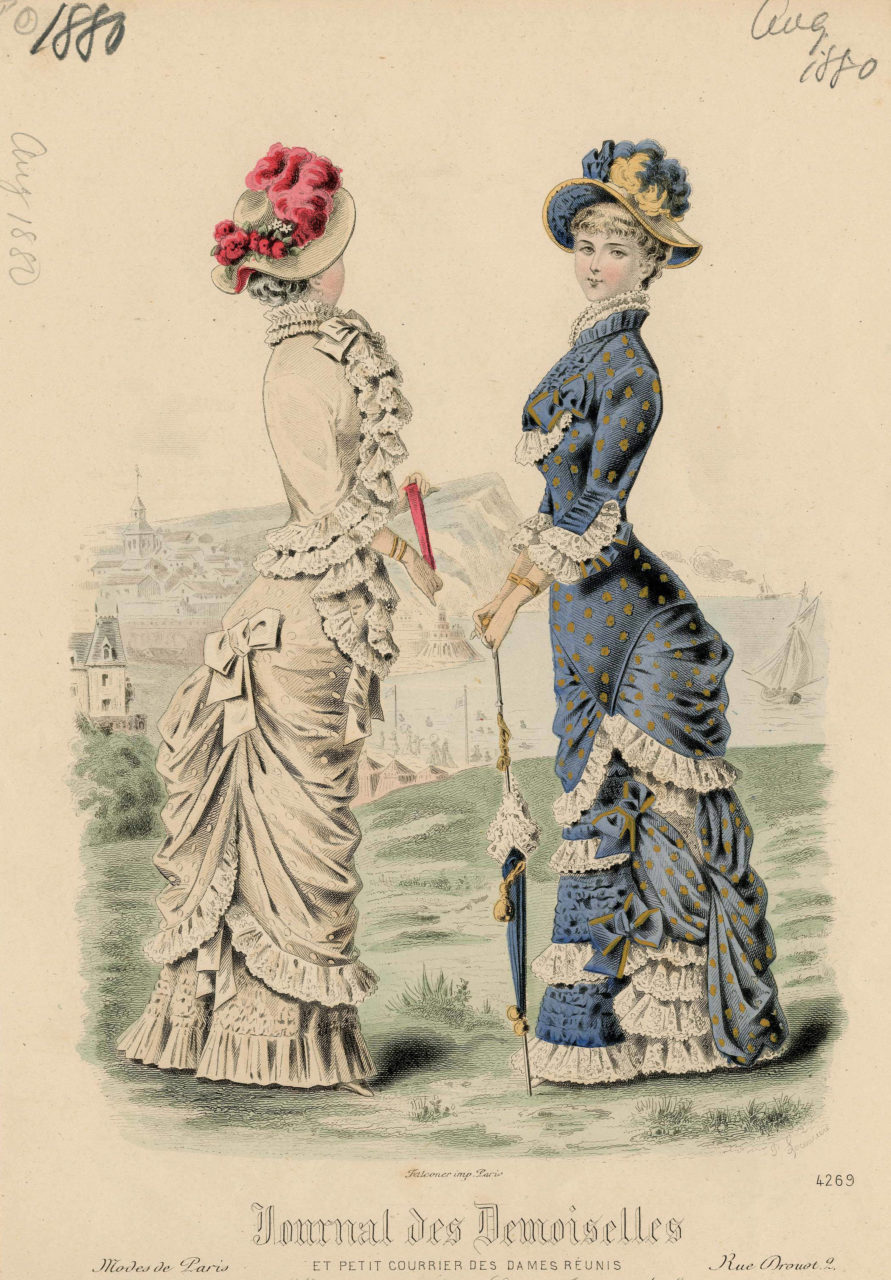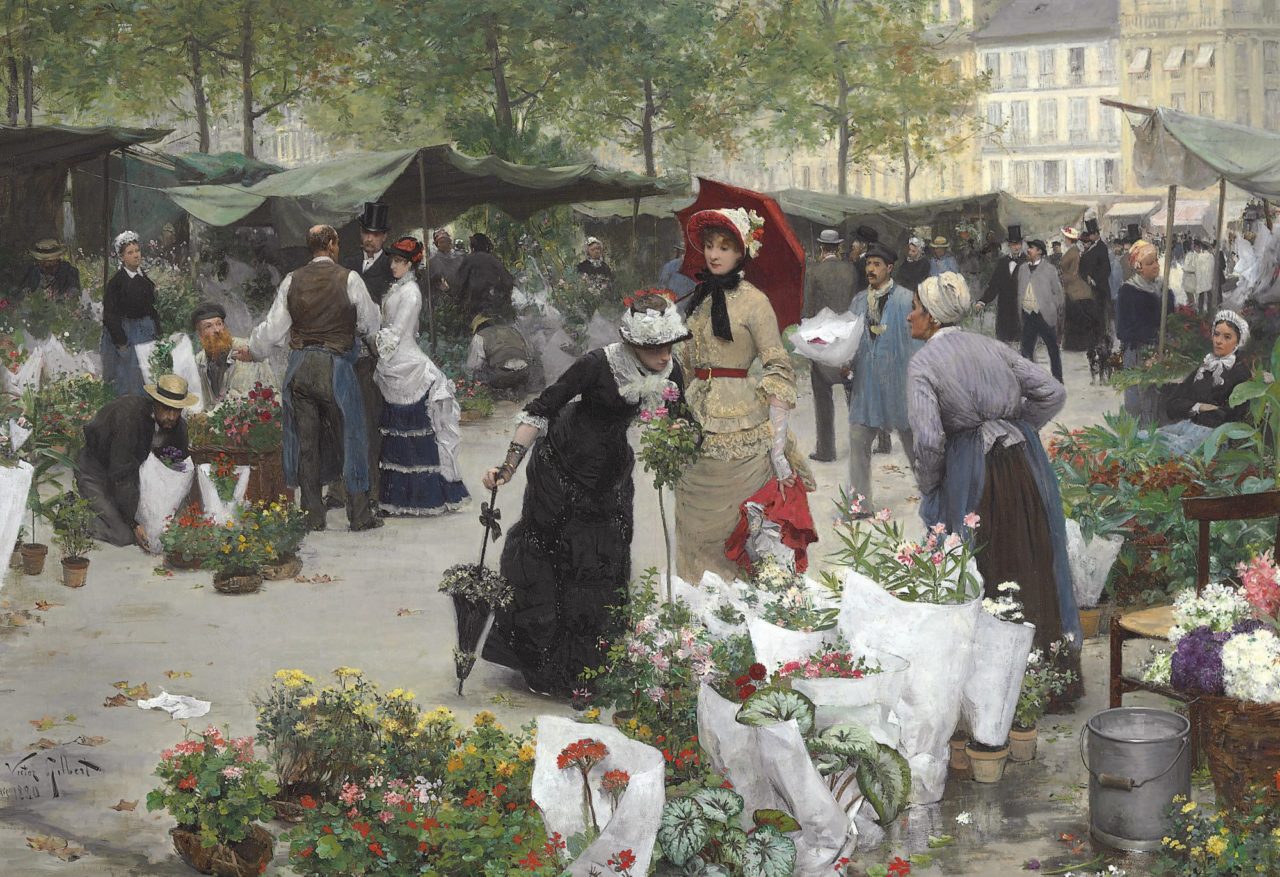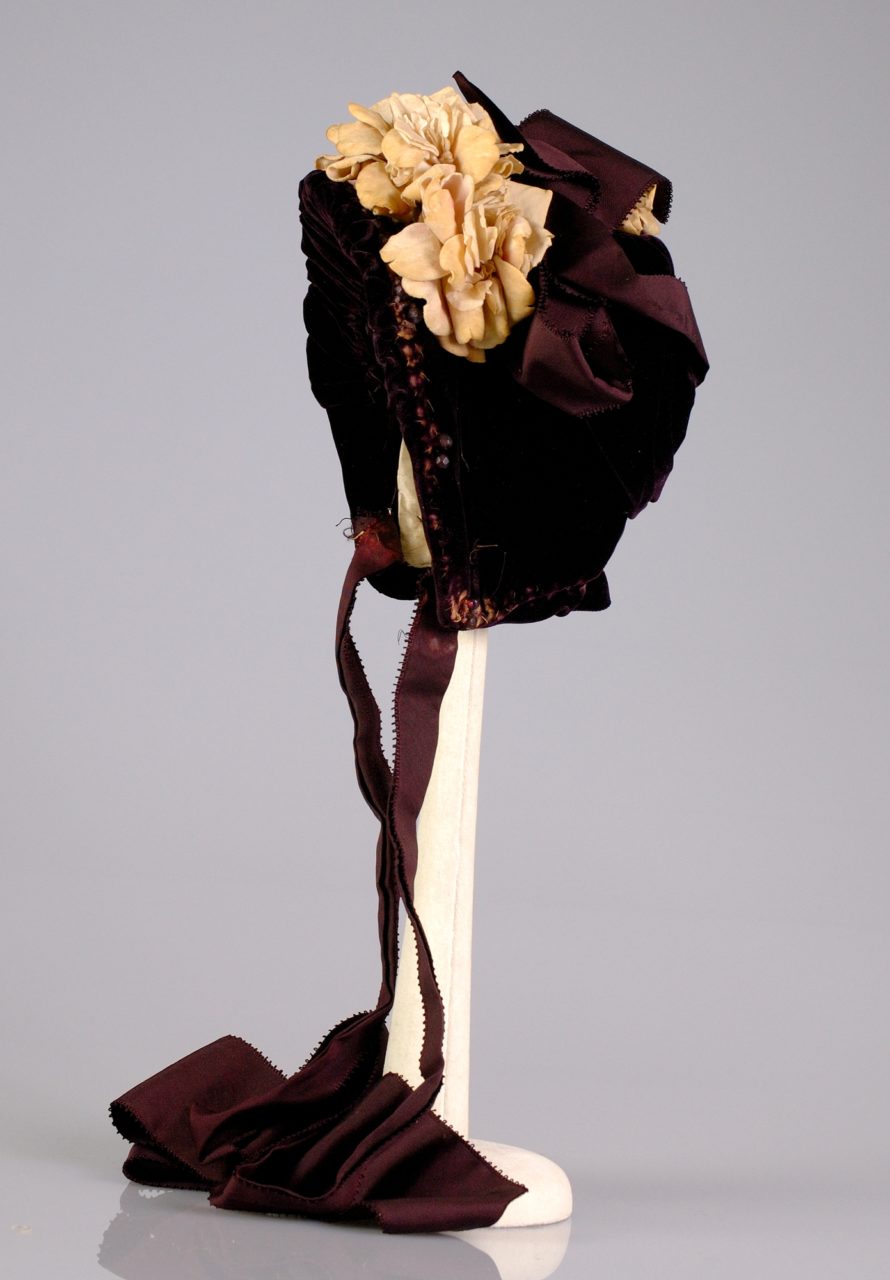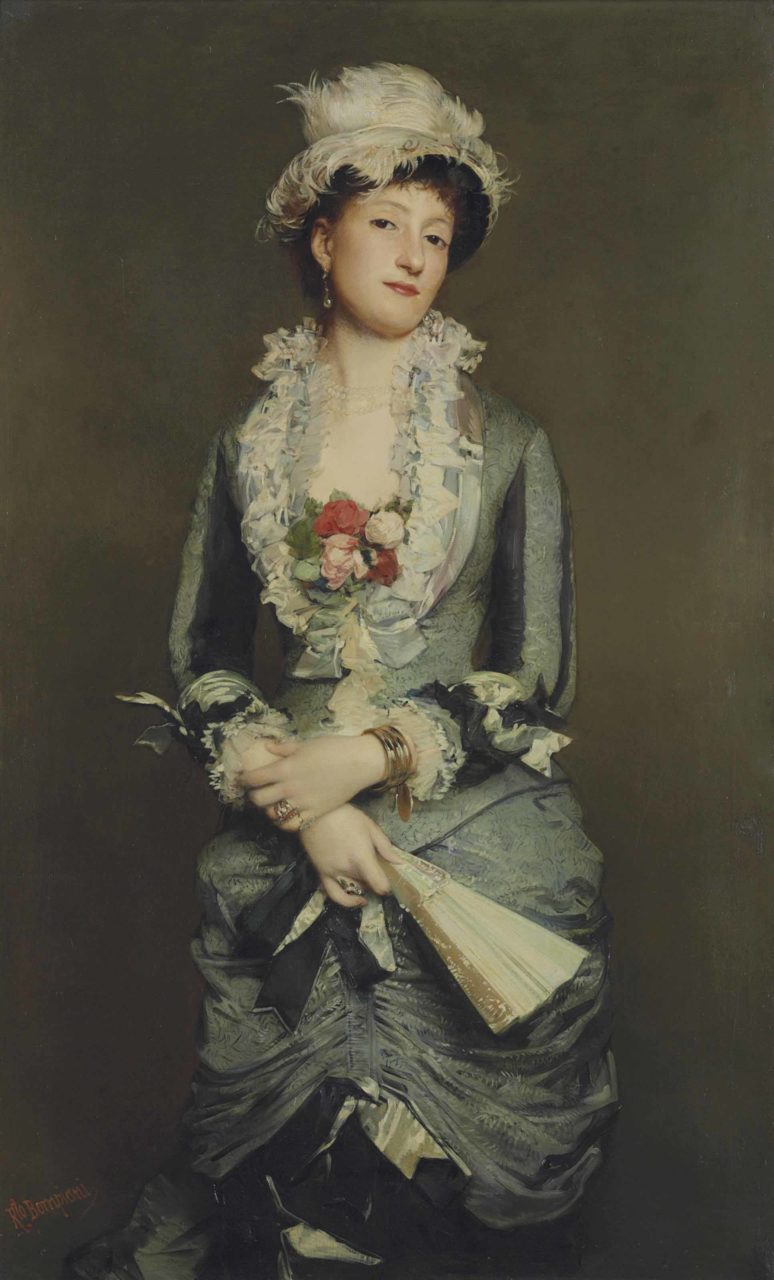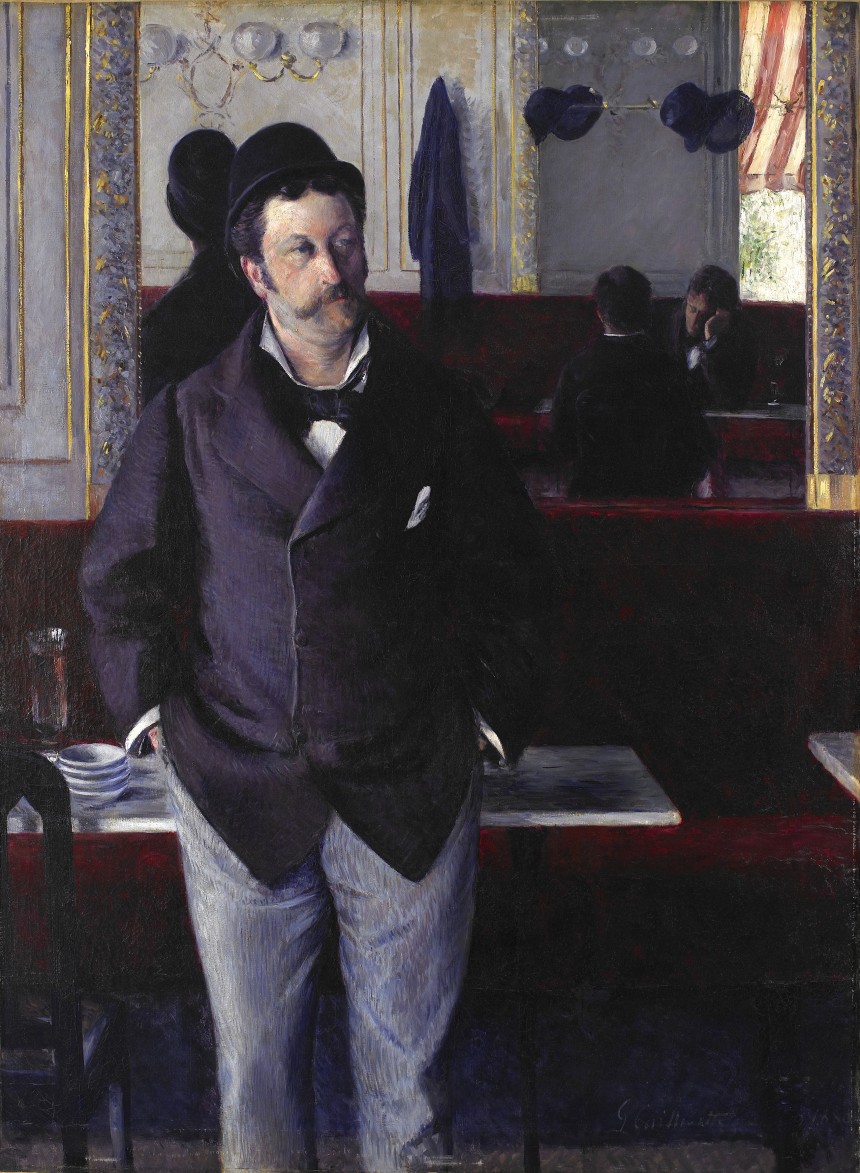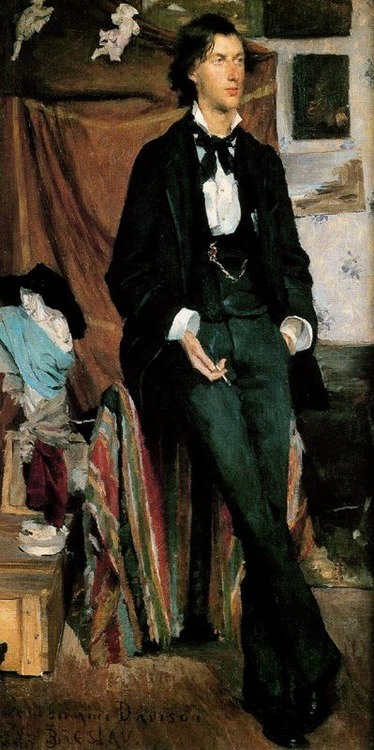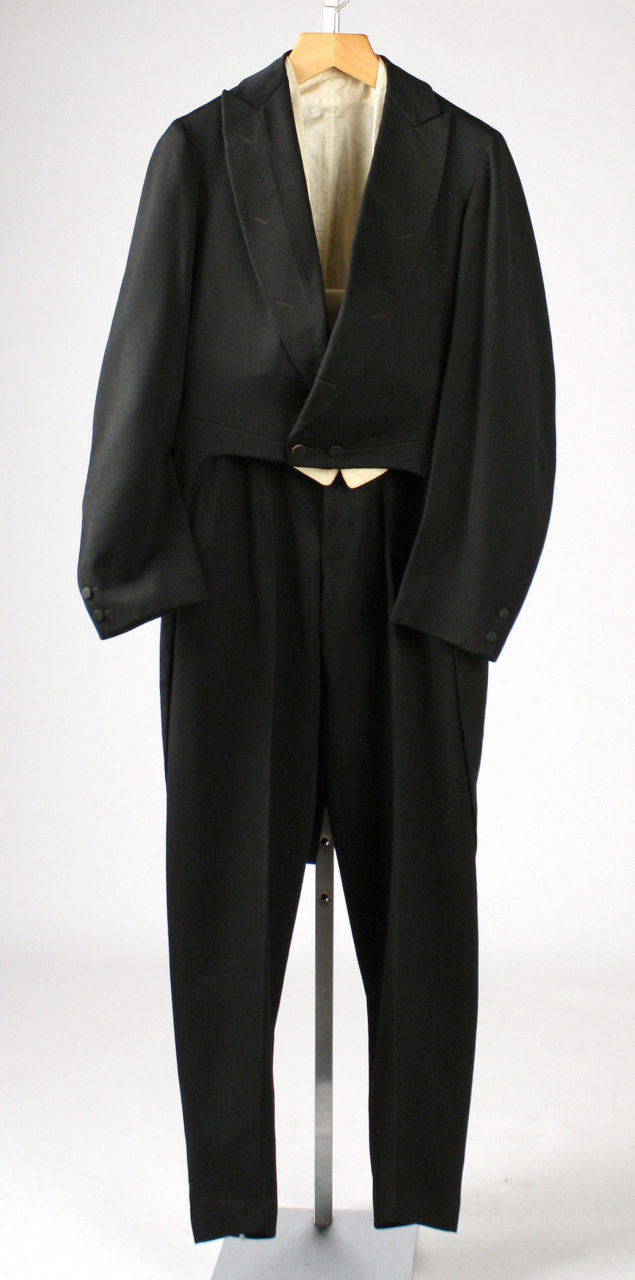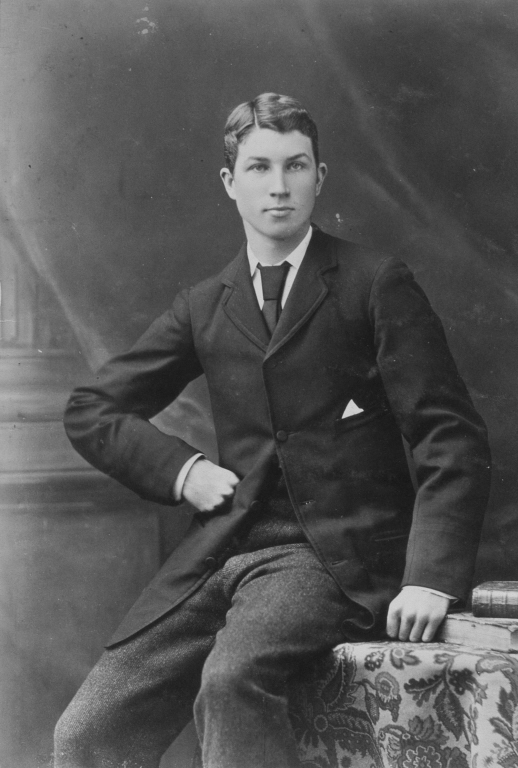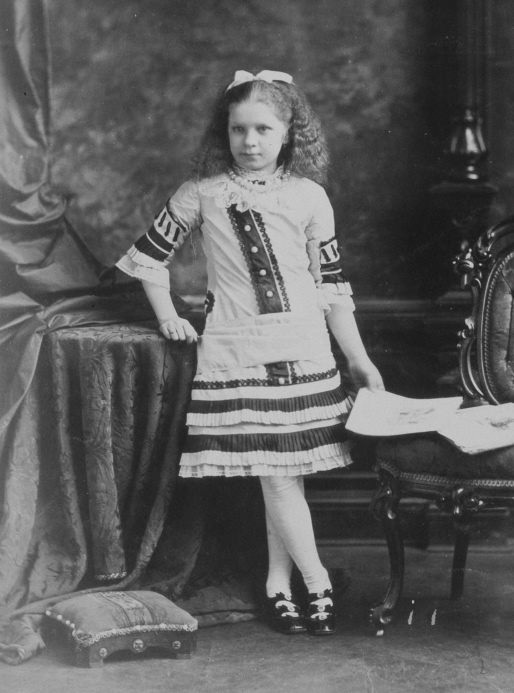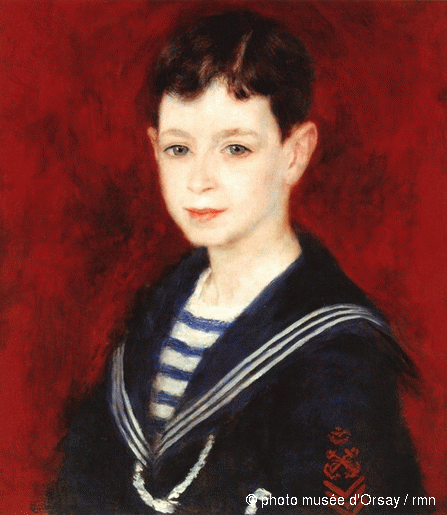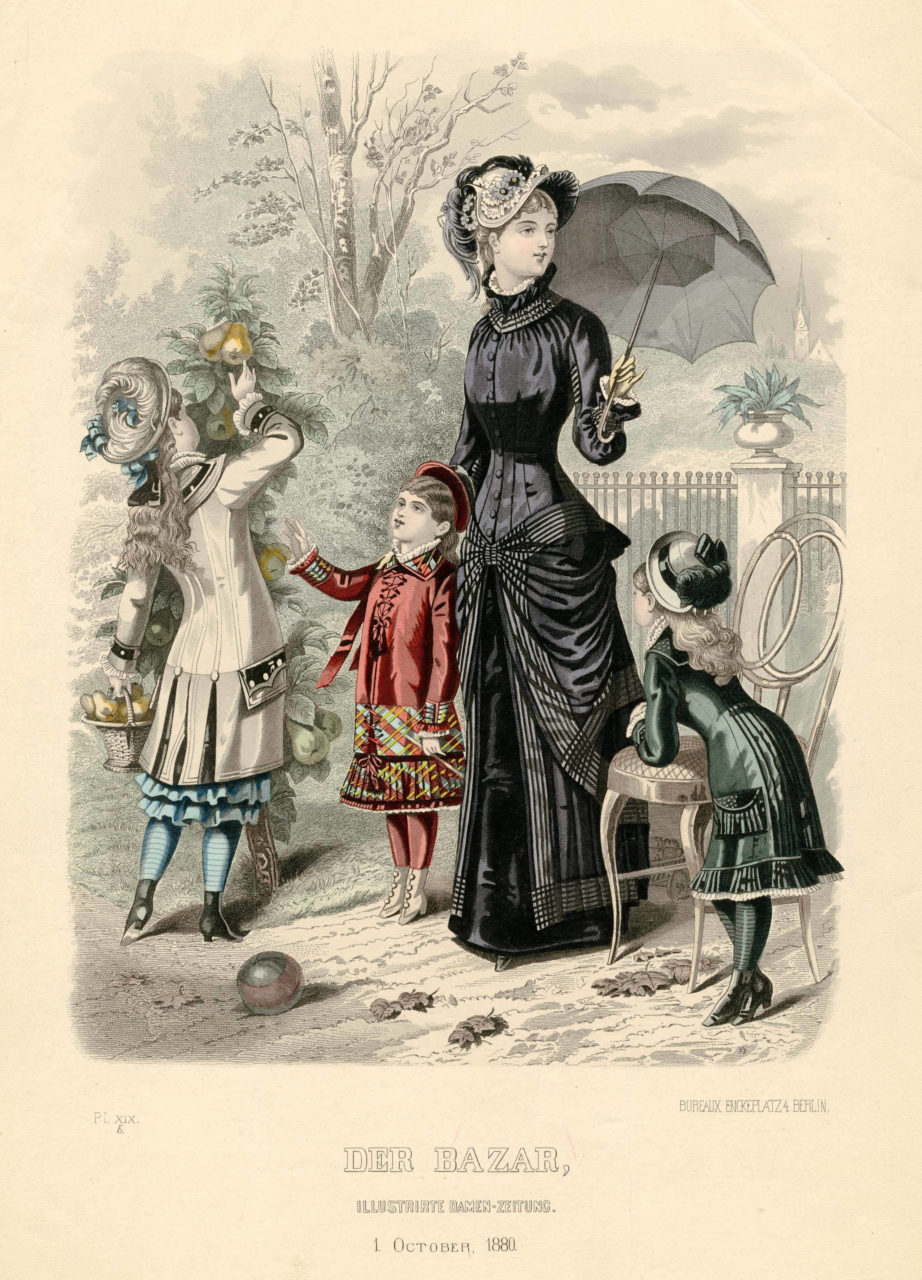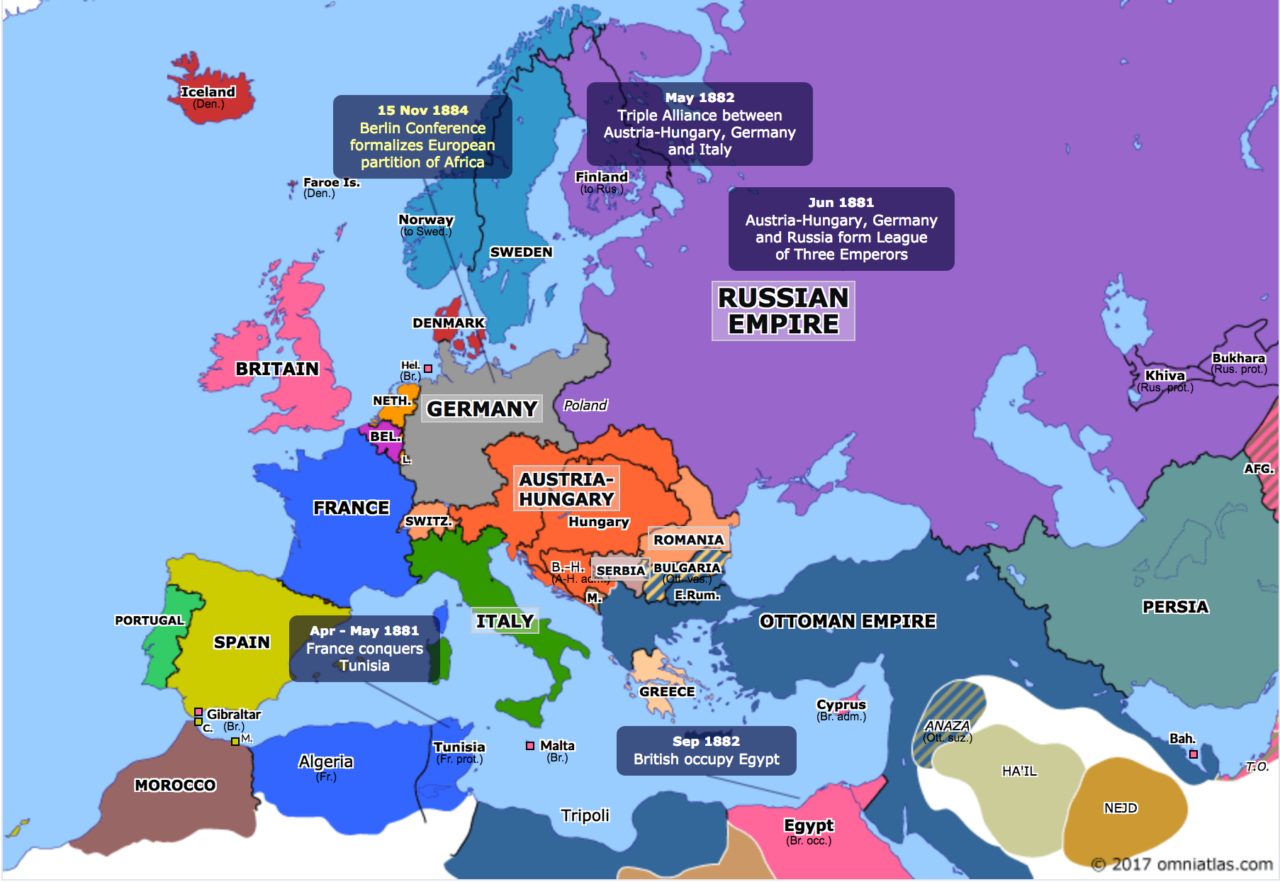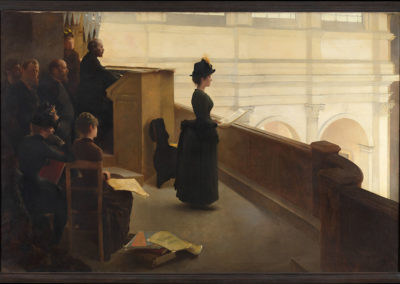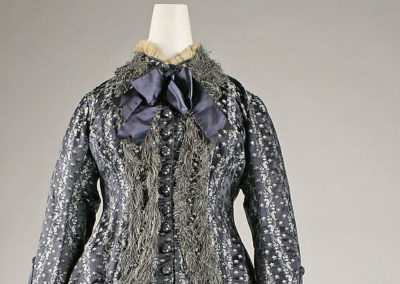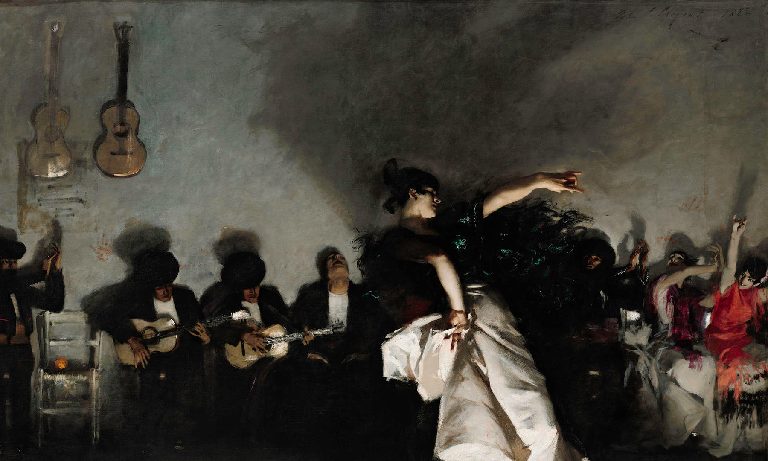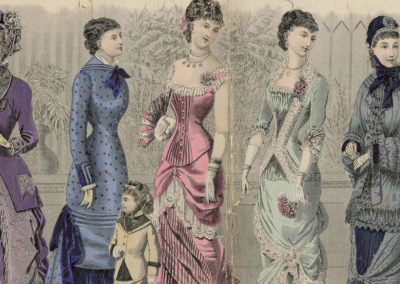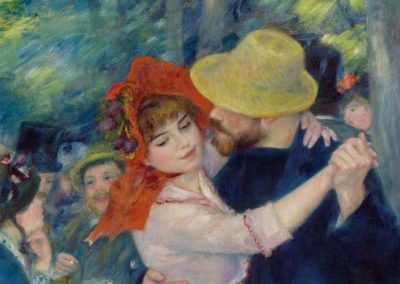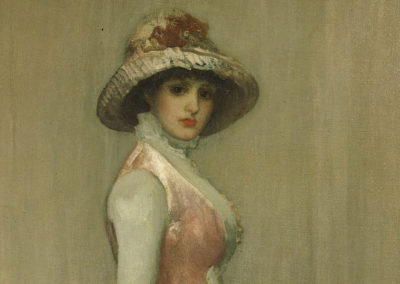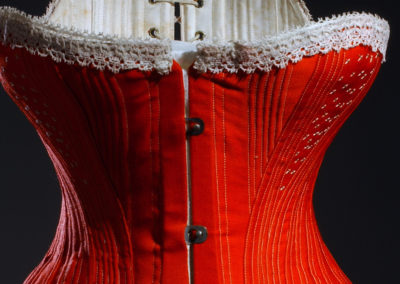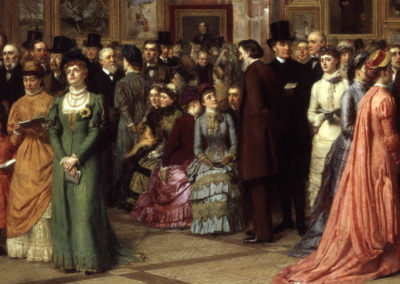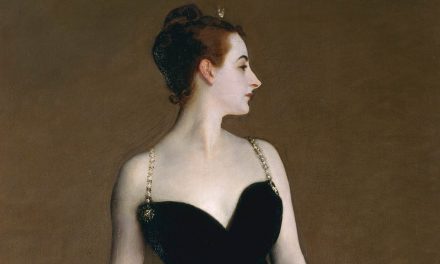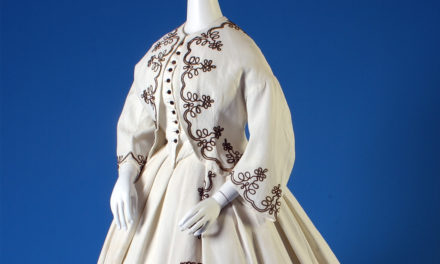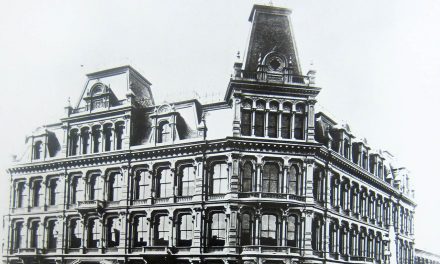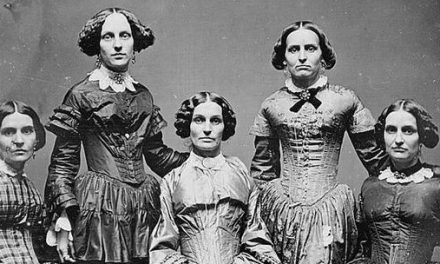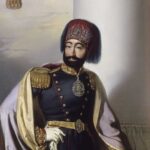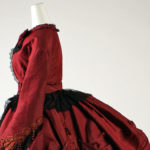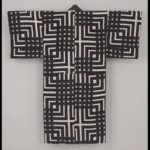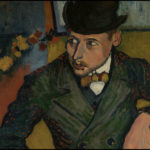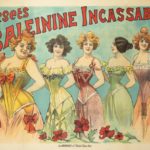OVERVIEW
Basque bodices with lace trimming were highly fashionable for women in the year 1880. Polka-dotted textiles appeared frequently in fashion plates, and the color purple was considered stylish.
Womenswear
T
he coat-basque, a long, coat-like bodice that fully encased the torso and often extended into coat-tails resembling the back of a man’s frock coat (Fig. 1), was extremely fashionable during the 1880s. This popularity, which came out of the late 1870s and lasted into the 1890s, is referenced in an 1880 column titled “Fashions for April” in Peterson’s Magazine:
“There is no decided change in the style of making dresses; short ones are always seen on the street; narrow and flat skirts in front, little draping in the back with coat-basques, mantillas or basques, just as fancy dictates. Much lace is used for trimming dresses, especially about the neck. Mantles and jackets are of all varieties.” (328)
As it was a basic bodice shape in this period, a basque could be trimmed and cut in a variety of ways. The gown in figure 2 has ostentatiously long coat-tails in comparison to figure 1, and the fashion plate in figure 3 shows that decorations on the front of the bodice varied widely, as well as the neckline and hem shapes. The April 17th issue of Harper’s Bazar describes another:
“The coat basque is an excellent model, and is very stylishly ornamented with a color or plastron set on, and so deeply pointed in front that it gives the effect of a vest.” (243)
In figure 3, note how the bodices on the purple and blue gowns appear to be full jackets – these are coat-basques. The green gown has a ruched plastron set into its basque, and a similarly pointed, vest-like example can be seen in figure 4, a Jacques Doucet dress in the Met’s collection.
Godey’s Magazine describes indoor jackets in the basque cut in its December 1880 column “On Fashions for December”:
“Very pretty indoor jackets are made in the casaquin style, molding the waist and coming down low over the hips. The front is trimmed from the neck down to the waist line with a lace quilting.” (588)
These long-waisted paneled bodices were given several names, including basque, cuirass, and casaquin. The latter comes from the Louis Seize revival style and refers to the eighteenth-century casaquin jacket, similar to a caraco; it was often paired with draped fabric ‘panniers’ at the hips. Even the shorter styles of basque bodice (Fig. 5) still extended beyond the waist without a seam. This enabled the creation of a longer and more fitted torso silhouette.
Various shades of purple became the summer color of 1880, although Peterson’s Magazine did not believe the color was appropriate for everyone. The April issue said:
“Of the new color heliotrope is very fashionable; but it is not becoming to many people, as it is of a pinkish purple; but many of the lavenders and lilacs are eminently becoming.” (328)
An at-home gown in a remarkably unfaded heliotrope purple appears in figure 6. Harper’s Bazar’s “New York Fashions” column in the April issue said on the color purple:
“Sometimes two colors appear in the dress, especially in the light cream and mastic foulards that are combined with prune, heliotrope or garnet brocades.” (243)
The dark prune-purple and cream gown in figure 7 must have been perfectly on-trend.
Fig. 1 - Artist unknown (American). Suit with coat-tail basque corsage, February 1879. New York Public Library, Frank Leslie's ladies' magazine. v. 44 (Jan-June 1879): 85. Source: Hathitrust
Fig. 2 - Designer unknown (French). Dress, 1880. Silk, cotton. New York: Metropolitan Museum of Art, C.I.55.40.4a, b. Gift of Miss Margaret W. McCutchen, 1955. Source: MMA
Fig. 3 - Artist unknown (American). Godey's Lady's Book, December 1880. Fashion plate. New York: Metropolitan Museum of Art, b17509853. Gift of Woodman Thompson. Source: MMA Digital Collections
Fig. 4 - Jacques Doucet (French, 1853–1929). Dress, ca. 1880. Silk, cotton. New York: Metropolitan Museum of Art, 1984.337a, b. Purchase, Irene Lewisohn and Alice L. Crowley Bequests, 1984. Source: MMA
Fig. 5 - Wexler & Abraham (department store) (American). Evening dress, ca. 1880. Silk. New York: Metropolitan Museum of Art, 2009.300.654. Brooklyn Museum Costume Collection at The Metropolitan Museum of Art, Gift of the Brooklyn Museum, 2009; Gift of the estate of Miss S. E. White, 1939. Source: MMA
Fig. 6 - Designer unknown (American). Purple silk and velvet bustle gown, ca. 1880. Silk faille and velvet; (bust 36", waist 26" in). Lot: 101, May 8, 2018 - Vintage Clothing & Accessories, Sturbridge, MA. Source: Augusta Auctions
Fig. 7 - Designer unknown (American). Afternoon dress, ca. 1880. Silk, abalone. New York: Metropolitan Museum of Art, 2009.300.967a, b. Brooklyn Museum, 2009; Gift of Judith Applegate, 1975. Source: MMA
The color purple was not the only guiding trend of 1880 – polka-dots featured prominently as well. Harper’s Bazar said in their April 10th, 1880 issue:
“Polka-dotted stuffs are imported this season, and manufacturers design them in quiet colors with a view to replacing plain solid colors… But the polka-dotted patterns appear especially in three spring fabrics, viz.., buting, tamise cloth, and camel’s hair.” (227)
A perfect example of the confluence of both of these fashionable trends is the 1880 gown worn by Madame Bartholomé for her husband Albert Bartholomé’s 1881 painting Dans la serre. The gown (Fig. 8), in white and purple cotton with polka-dots and stripes, has a long basque bodice and a collar reminiscent of the sailor style. The fine, narrow kilted pleats of the skirt were also highly fashionable, their tiny multitudes matching the polka dots and buttons. The painting, done a year later, reproduced the gown faithfully down to the darts in the bodice and the bits of white showing through the pleating. The dressmaker appears to have taken advantage of the striped cotton used for the sleeves and pleated it so that only the purple showed on the outside, and so the white is only visible when the pleats move.
Polka-dots, or spots (or “pois” in French), continued to be all the rage in the June 1880 issue of Godey’s Magazine. In “Chitchat, On Fashions For June,” the editor wrote:
“The fancy for spotted dress goods has rapidly increased as the season has advanced; spots are the rage now, walking dresses are made of bright-colored foulard silk with white spots, and cream and other light colored ones, with spots of red and blue.” (108)
This polka-dot trend was a way to incorporate more colors into an ensemble and to add visual interest to a dress that would otherwise be in large color-blocks (Fig. 10). They could be a single color or multicolored (Fig. 11). Spots were commonly used as an all-over pattern, and sometimes in subtler ways than others: while the gold dots on the blue dress in figure 12 are obvious, there are spots on the white dress at left as well.
Fig. 8 - Designer unknown (French). Robe de Mme Albert Bartholomé, 1880. Cotton. Paris: Musée d'Orsay, ODO 1991 1. Gift of the Charles and André Bailly Gallery, 1991. Source: M'O
Fig. 9 - Albert Bartholomé (French, 1848-1928). Dans la serre, 1881. Oil on canvas; h. 235 x l. 145 cm. Paris: Musée d'Orsay, RF 1990 26. Source: M'O
Fig. 10 - Designer unknown (American). Dress, 1880–83. Cotton, silk. New York: Metropoitan Museum of Art, C.I.38.8.1a, b. Gift of Mrs. Agnes Kremer, 1938. Source: MMA
Fig. 11 - A. Chaillot (French). Revue de la Mode, Gazette de la Famille, dimanche 1 août 1880, 9e année, No. 448, August 1880. Fashion plate. Amsterdam: Rijksmuseum, RP-P-OB-103.625. Source: Rijksmuseum
Fig. 12 - Artist unknown (French). Journal des Demoiselles, August 1880. Fashion plate. New York: Metropolitan Museum of Art, b17509853. Gift of Woodman Thompson. Source: MMA Digital Collections
In Victor Gabriel Gilbert’s 1880 painting Le marché aux fleurs (Fig. 13), the two central figures are shown wearing stylish examples of spring fashion from the 1880. Both women have on basque bodices – not quite long or stiff enough to be coat-basques – trimmed with ruffles and lace. Their bodices have high necklines with added visual interest from a white fichu and a black hat ribbon, adding contrast in an attractive 1880 style.
Both women are wearing head coverings, which were required for any woman of means to leave the house in the 19th century. These bonnets or hats were usually adorned with coordinating trimmings like lace, ribbons, and flowers, and could be swapped out for different seasons (Fig. 14). Hats were a key topic of interest in women’s fashion, and they were typically mentioned in a standard column in a fashion publication. In 1880, hats came in a wide variety, but tended to be small-brimmed (Fig. 15). Bonnets sat towards the back of the head without a brim. The elongated bodices, the lace trimmings, and matching bonnets make the two women in the flower market fashionable for the year 1880.
Fig. 13 - Victor Gabriel Gilbert (French, 1847–1933). Le marché aux fleurs, 1880. Oil on canvas; 74.3 x 107.3 cm (29.3 x 42.2 in). Private collection. Source: Wikimedia Commons
Fig. 14 - Mme. Mantel (French). Bonnet, ca. 1880. Silk, cotton. New York: Metropolitan Museum of Art, 2009.300.4198a–c. Brooklyn Museum, 2009; Gift of the Princess Viggo, 1931. Source: MMA
Fig. 15 - Roberto Bompiani (Italian, 1821-1908). Lady with a Fan, ca. 1880. Oil on canvas; 136.2 x 83.2 cm (53 5/8 x 32 ¾ in). Christie's, Lot 48, Sale 10399 (19th Century European & Orientalist Art, London, 15 June 2015). Source: Christie's
Menswear
Fig. 1 - Gustave Caillebotte (French, 1848 - 1894). In a Café, 1880. Oil on canvas. Rouen: Musée des Beaux-Arts, D.946.1. Source: Musée des Beaux-Arts
Fig. 2 - Louise Breslau (French, 1856–1927). Henry Davison, ca. 1880. Oil on canvas; 87 x 46 cm. Paris: Musée d'Orsay, RF 1977 424. Source: Musée d'Orsay
Fig. 3 - Maker unknown (American). Suit, ca. 1880. Wool, linen. New York: Metropolitan Museum of Art, 1991.388a–f. Gift of June Wooden Dudley Bliss, 1991. Source: MMA
Fig. 4 - Notman & Sandham (Canadian). L. G. Doran, Montreal, QC, 1880, 1880. Silver salts on paper mounted on paper - albumen process; 15 x 10 cm. Montreal: McCord Museum, II-55363.1. Purchase from Associated Screen News Ltd.. Source: MMC
CHILDREN’S WEAR
Fig. 1 - Notman & Sandham (Canadian). Miss J. Ogilvie, Montreal, QC, 1880, 1880. Silver salts on paper mounted on paper; albumen process; 15 x 10 cm. Montreal: McCord Museum, II-54882.1. Purchase from Associated Screen News Ltd.. Source: MMC
Fig. 2 - Auguste Renoir (French, 1841–1919). Fernand Halphen enfant, 1880. Oil on canvas. Paris: Musée d'Orsay, RF 1995 12. Source: Musée d'Orsay
Fig. 3 - Artist unknown (German). Der Bazar, October 1880. Fashion plate. New York: Metropolitan Museum of Art, b17520939. Gift of Woodman Thompson. Source: MMA Digital Collections
References:
- “Chitchat On Fashions For December.” Godey’s Lady’s Book and Magazine. (December 1880): 588. https://babel.hathitrust.org/cgi/pt?id=chi.57766453;view=1up;seq=514
- “Chitchat On Fashions For June”. Godey’s Lady’s Book and Magazine. (June 1880): 108. https://babel.hathitrust.org/cgi/pt?id=chi.57766453;view=1up;seq=94
- “Fashions for April.” Peterson’s Magazine, vol. 77-78. (April 1880): 328. Google Books.
- “New York Fashions.” Harper’s Bazar, vol. XIII, no 15. (April 10, 1880): 227. HEARTH.
- “New York Fashions.” Harper’s Bazar , vol. XIII, no 16. (April 17, 1880): 243. HEARTH.
Historical Context
Wikipedia: 1880
Rulers:
- America:
- President James Garfield (1881; elected 1880)
- England: Queen Victoria (1837-1901)
- France:
- President Jules Grévy (1879-87)
- Spain:
- King Alfonso XII (1874-85)
Europe 1884. Source: Omniatlas
Timeline Entries
Primary/Period Sources
Resources for Fashion History Research
To discover primary/period sources, explore the categories below.
Have a primary source to suggest? Or a newly digitized periodical/book to announce? Contact us!
Fashion Plate Collections (digitized)
- Costume Institute Fashion Plate collection
- Casey Fashion Plates (LA Public Library) - search for the year that interests you
- New York Public Library
NYC-Area Special Collections of Fashion Periodicals/Plates
- FIT Special Collections (to make an appointment, click here)
- Costume Institute/Watson Library @ the Met (register here)
- New York Public Library
- Brooklyn Museum Library (email for access)
Womenswear Periodicals (Digitized)
Etiquette Books (Digitized)
Menswear Periodicals / Etiquette Books (Digitized)
Secondary Sources
Also see the 19th-century overview page for more research sources... or browse our Zotero library.

